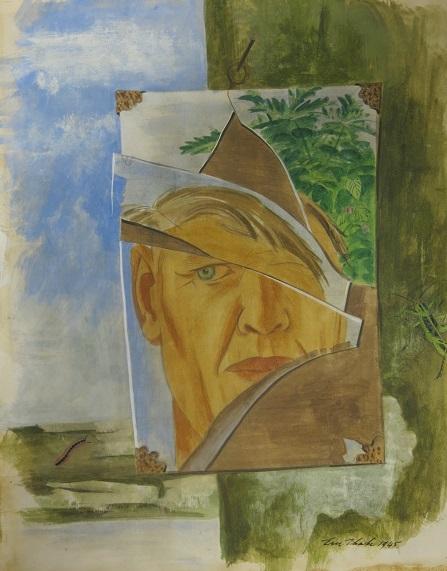New Art Acquisition by Eric Thake
Eric Thake, Self-portrait in a broken shaving mirror
One of only two self-portraits by Eric Thake produced during his Official War Artist commission, 1944-45.

Eric Thake (1904-1982) was a Modernist painter with an interest in Surrealism, a style that developed in the early 1920s, best known for its contradictory and illogical scenes, expressing unconscious ideas and concepts. His contemporary approach to art made him an unlikely appointment as an Official War Artist to cover RAAF operations from 1944 to 1945. Thake’s biographer identified that he ‘had previously shown little interest in painting figures, and had even less interest in aircraft.’ [1]
Despite this, as a war artist attached to Royal Australian Air Force (RAAF) in Australia and then in Morotai , Penfoei and Koepang in the Netherlands East Indies ,Thake was able to consolidate his artistic style. His adept handling of his materials enabled him to build up a series of paint layers which reflected the complexity of the subject matter provided by the war. The gouache medium suited Thake’s direct, methodical and decisive approach to the selection of his subjects which mainly derived from his immediate surroundings.
Self-portrait in a broken shaving mirror (1945) in which Thake’s own face is reflected as a fractured and distorted image in a broken mirror nailed to a tree, provides a psychological insight into the artists’ experience. The fragmentation of the portrait introduces a watchful wariness of what might be behind him which was an ever present fear during the context of war. The yellowness of his skin is due to the Atebrin tablets which were taken to prevent malaria. The portrait reflected in the broken mirror is a powerful, honest and raw portrayal of the artist.
The natural flora and fauna on Noemfoor Island included green grasshoppers, millipedes and the pink flowered passion vine which ran wild and provide a suitable analogy to the experience of war. Thake was so deeply moved by the landscape he encountered that he included reference to it in this self-portrait and in his correspondence home. Later that year the minutia of insect life he saw in Netherlands East Indies began to assume in his paintings the forms of wrecked and abandoned aeroplanes, as in Liberator’s face (ART26970) and Wrecked Lodestar (1945) (ART26790). In his use of anthropomorphism, Thake introduced some uncertainty about the division between life and death. The wrecked airplanes seemingly come to life, with the inclusion of eyes and wide gaping proboscis and wings.
Thake is now recognised as one of Australia’s most notable Modernist artists and is currently represented in the Australian War Memorial’s exhibition ‘Reality in Flames: Modern Australian Art and the Second World War’ which will be on display at the Memorial from July 2016.
[1] Peter Pinson, ‘Eric Thake: A surrealist at war’, Art Monthly Australia, Issue no.274, October 2014, p.50.
